FEATURE
STORIES
Launched
Late astronaut Ronald McNair's namesake federal program prepares talented scholars from underrepresented backgrounds for careers in research and teaching
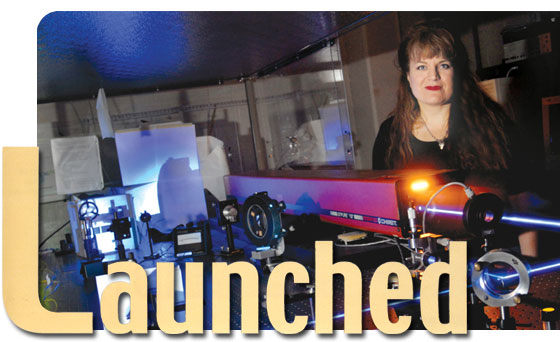
Alumna Debra Wawro is CEO of Resonant Sensors Inc., a high-tech firm with medical and environmental applications.
ebra Wawro develops technology that could revolutionize the pharmaceutical industry. Scott Pesiridis analyzes brain tissue for clues to what causes Lou Gehrig’s disease. Nicole Campbell helps the government detect paramilitary groups hidden in wooded areas.
All built their research careers on a common foundation: UT Arlington’s Ronald E. McNair Postbaccalaureate Achievement Program.
Named for the astronaut who died in 1986 aboard the space shuttle Challenger, the federally funded initiative helps promising undergraduates from low-income/first-generation or under-represented backgrounds become professors. Its premise is that neither socioeconomic nor minority status should prevent talented students from pursuing higher education careers in teaching and research.
“Some of these students feel like they can’t compete,” says Associate Director Joan Reinhardt, who oversees the program. “We help even the playing field. We tap into their skills to help them achieve what they’re capable of achieving.”
Campbell could be the McNair poster child. Urged by Dr. Reinhardt to pursue graduate school, the 2002 electrical engineering alumna doubted she was ready. So she hatched a plan.
“I applied to the top 10 engineering and science schools in the country because I was sure they would say no,” she said. “Then I could go back and tell Dr. Reinhardt that no one accepted me, and I’d be off the hook.”
The scheme backfired.
All 10 universities accepted Campbell. The list included Stanford, the California Institute of Technology, Cornell, Georgia Tech and Carnegie Mellon. With Reinhardt’s help, Campbell narrowed the field to two, finally choosing Michigan over Notre Dame.
In addition to help in selecting and applying to a graduate school, the program offers free tutoring and GRE preparation courses. Perhaps its most valuable component is a summer-long research experience under a faculty mentor’s supervision. Campbell worked alongside electrical engineering Professor Ronald Carter on a project for National Semiconductor.
Bioengineering Assistant Professor Kytai Nguyen has a dual perspective. She was a McNair Scholar as a chemical engineering major at the University of Minnesota-Twin Cities. She went on to earn her Ph.D. in chemical engineering/bioengineering at Rice University and has mentored two students as a UT Arlington faculty member.
“The program helped me develop my research skills and gain access to graduate school,” she said. “As a mentor, I’m able to help students just like me to have a better future.”
McNair Scholars receive a $3,000 stipend and spend 30-40 hours a week on their projects. The venture lays the groundwork for more in-depth research at the graduate level.
The business of research
Tucked away in a first-floor corner of Nedderman Hall behind wooden doors with no name exists a start-up company with the potential to transform crucial facets of the medical, homeland security and environmental fields.
The brainchild of Wawro (’97 BSEE, ’99 MSEE) and Robert Magnusson, Resonant Sensors Inc. uses diffractive optics to reflect color changes in biochemical reactions. Tests that now take drug developers up to 24 hours can yield results in less than 15 minutes with RSI’s technology.
“This sensor lets you see chemical reactions in real time,” says Wawro, an electrical engineering Ph.D. candidate. “Pharmaceutical companies can look for compounds to help treat disease. It can also be used to detect anthrax and measure water quality.”
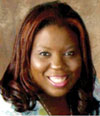
"I always dreamed I was going to be a physicist. I had never seen a black scientist before. But my mother told me I could do whatever I wanted to do."
- University of Michigan Ph.D. candidate Nicole Campbell ('02 BSEE)
Wawro’s interest in optics began before she became a UT Arlington McNair Scholar. She studied alongside Dr. Magnusson, a former Electrical Engineering Department chair, in the National Science Foundation’s Research Experience for Undergraduates. The work continued in the McNair program and contributed to her master’s thesis, which, in turn, provided the technology that led to RSI’s genesis.
Co-founded by Wawro and Magnusson using intellectual property licensed through UT Arlington, RSI leases its lab space from the Arlington Technology Incubator, which helps start-ups take their research to the marketplace. Wawro is CEO and chief scientist, and Magnusson is chief technology officer.
“To work on projects with the potential to make an impact was important to me,” Wawro, a first-generation college student, says of her undergraduate research. “It enabled me to have better employment opportunities and gave me the chance to pursue a graduate degree.”
And start a company that recently received an excellence in innovation award from the Commerce Department. Though passers-by may be oblivious to the high-tech firm, funding agencies have it squarely in their sights. RSI has received four National Science Foundation grants and one from the Texas Emerging Technology Fund.
In announcing the $600,000 TETF award last summer, Texas Gov. Rick Perry called the sensors revolutionary and cited emerging technology as the “lifeblood of today’s economy.” The funding enabled RSI to begin targeting its product to pharmaceutical companies in January.
Wawro traces her success to her McNair experience. “It gave me confidence and made me realize that I have creative ideas,” she said. “It taught me the importance of being open to trying new techniques and methods.”
Driven to beat the odds
According to The Chronicle of Higher Education, 0.4 percent of African-American women in the United States earned doctoral degrees in 2006. Of that small percentage, only a fraction received science and engineering Ph.Ds.
Nicole Campbell and Jennifer Jamison are bucking the trend.
Friends since joining the McNair program in 2002, their cross-country cellphone conversations often last for hours and cover a range of personal and professional topics: dating struggles, research, their futures and the challenges of being minority women in male-dominated fields.
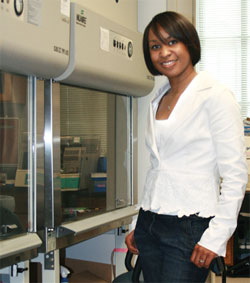
"We promised ourselves we would make it to the finish line. We kid about calling each other Dr. Campbell and Dr. Jamison."
- Rice University Ph.D. candidate Jennifer Jamison ('03 BS)
“We promised ourselves we would make it to the finish line,” says Jamison, who is scheduled to complete her chemistry Ph.D. at Rice University this summer. “We kid about calling each other Dr. Campbell and Dr. Jamison.”
Campbell, who is studying applied physics, could receive her real doctor title by the end of the year. Along the way, she has racked up an impressive list of honors, including the 2007 National GEM Consortium Most Promising Ph.D. Fellow Award for her research achievements and work with minorities in science, engineering, technology and mathematics.
One research project involves scattering models used for foliage-camouflaged target identification. “With the models, we can detect tanks, weaponry, housing—anything hidden in forest regions,” she says.
For another, she developed an algorithm now being used by the Atmospheric Radiation Measurement program. Supported by the Department of Energy, ARM is a key contributor to national and international research related to climate change.
It’s complex work that, when explained in detail, can make the non-scientific head spin. But Campbell has always had a flair for science. Though neither of her parents graduated from high school, they stressed education in their modest Monroe, La., home.
“I always dreamed I was going to be a physicist. I had never seen a black scientist before. But my mother told me I could do whatever I wanted to do. So I kept forging ahead and hoping for the best.”
What distinguishes Campbell from many doctoral candidates, especially those in science and engineering, are her interests beyond the laboratory. She served three years on the Michigan Student Assembly and helped get 10,000 students registered to vote. Somehow she found time to write a textbook published by Addison-Wesley in 2007.
At Rice, the soon-to-be Dr. Jamison works with nanotechnology. One project seeks to ensure that nanoparticles used to treat diseases can travel safely through the body’s smallest blood vessels. Another centers on attaching proteins to nanomaterials and could lead to new types of noninvasive cancer treatments.
Between laughs, she spouts words like ultracentrifugation and nanobioconjugates with kid-on-the-playground excitement. Her vivaciousness has caused some to doubt her intellect.
“I figured if I chose science, people would think I was reasonably smart.” There’s that infectious giggle again. “I took all the classes and didn’t fail.”
Far from it. In 2003 she graduated cum laude from UT Arlington with a bachelor’s degree in chemistry; in 2005 she received her master’s in chemistry from Rice. A National Institutes of Health Keck Fellowship enabled her to cross-train as a nanobiologist. She’ll use that training as a postdoctoral biomaterials researcher at Texas A&M when she completes her Ph.D. Down the road, she wants to be a professor.
Campbell also has lofty goals: become a laboratory research fellow, then a laboratory director within 10 years. She also plans to publish a series of science and engineering textbooks.
You sense that neither woman will be sidetracked.
Breadth of discovery
The first UT Arlington McNair scholar to earn a Ph.D. was Chad Zutter. Now a finance professor at the University of Pittsburgh’s Katz Graduate School of Business, his research focuses on corporate finance, including initial and seasoned public offerings, mergers and acquisitions, and governance structure.
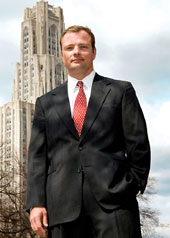
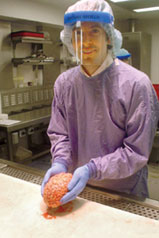
Scott Pesiridis, right, analyzes brain tissue in the Hospital of the University of Pennsylvania. Chad Zutter, left, was the first UT Arlington McNair scholar to earn a Ph.D.
One of his recent projects concluded that U.S. corporations scaled back their investment in risky ventures following the Sarbanes-Oxley Act of 2002. The findings were featured in The Economist and CFO magazines.
“The McNair Scholars Program is intended to give students exposure to the research process and encourage the pursuit of graduate studies,” says Dr. Zutter, who has won Katz’s Excellence in Teaching and Students’ Choice awards. “For me, it did just that.”
The 1996 UT Arlington graduate earned his master’s and doctoral degrees from Indiana University. His McNair research project compared price improvements on the New York Stock Exchange to those on regional stock exchanges. Presenting his work and hearing others’ presentations was a highlight.
“The diversity in scholars and research was really something special,” he says.
But his most memorable experience was watching a video tribute to Dr. McNair with his 85-year-old grandmother, who was visiting from Minnesota.
“My grandmother was very moved by Dr. McNair’s story. She was so proud of me for being part of the McNair Scholars Program that she began to cry.”
Scott Pesiridis’ kin were equally proud. The first-generation Greek American was the first in his family to attend college, but not the last. His sister and brother were McNair Scholars at the University of Colorado.
“The strength of McNair, for me, was to initiate a research experience,” says the 1996 chemistry graduate, who worked on a tool to measure enzyme activity in Professor Edward Bellion’s lab. “Once I was performing experiments, deciphering data and having fun, I quickly decided that a career in biochemical research was in my future.”
Dr. Pesiridis earned his Ph.D. at the University of Pennsylvania School of Medicine and is now a postdoctoral fellow at the Center for Neurological Disease Research in the Hospital of the University of Pennsylvania. He researches the biochemical processes that cause the accumulation of a pathological protein in the human brain.
The protein, TDP-43, builds up in patients with amyotrophic lateral sclerosis (Lou Gehrig’s disease) and frontal temporal dementia. Pesiridis designs model systems in a laboratory setting to mimic the protein pathology. The goal is to determine how TDP-43 malfunction and accumulation begins and then spreads into a disease-like state.
Although the McNair program particularly encourages science, engineering, technology and math majors to apply, it welcomes students from all disciplines.
Honors College anthropology alumna Faith Nibbs joined in 2004 and is now a graduate research assistant on full fellowship in the Anthropology Department at Southern Methodist University. Her dissertation is an extension of the research she did on Hmong refugees as a McNair Scholar under the direction of anthropology Adjunct Assistant Professor Joci Ryan.
The Hmong are Southeast Asian people who fought for the United States in the Vietnam War. When the war ended, their villages were burned. Many were resettled in America, including about 1,200 in Dallas.
- McNair Scholars Program Associate Director Joan Reinhardt
Nibbs is comparing the Dallas group to the smallest Hmong resettlement outside the United States, in Gammertingen, Germany. Beginning this summer, she’ll spend a year there doing field research partly funded by a Department of Homeland Security fellowship.
A mother of two who returned to college after her kids were grown, she credits the McNair experience with making her a competitive graduate school candidate.
“It really helps people from disadvantaged positions in life to realize that they have the potential to do something greater than graduate from college. You can go to graduate school; you can be a doctor,” says Nibbs, who was raised in a single-parent home. “People in marginalized communities don’t grow up with that message. McNair nurtures that message so we really believed it.”
The future of higher education
At least 25 scholars participate in the McNair program at all times. Last summer, industrial engineering senior Husein Anshur and mentor Brian Huff of the Automation & Robotics Research Institute used filtering techniques to make low-cost global positioning systems more accurate when detecting land mines.
The work was particularly meaningful for Anshur, a native of Somalia.
“I am from a war-torn country whose people suffered a lot from land mines. African governments are generally poor and can’t afford expensive mine detection systems. Neither can international humanitarian agencies.”
Anshur plans to pursue graduate degrees in industrial engineering and business administration.
“The McNair experience has given me the tools I need to make my plans a reality,” he says. “From educational support, to research experience, to the constant guidance we receive, I feel I’m ready for the challenges that lie ahead on my way to the doctorates.”
Program Associate Director Reinhardt, herself a first-generation college student, provides much of that direction. She’s part mother, part adviser, part guidance counselor. “It’s rewarding to see what the scholars end up doing,” she says. “We try to help them reach their potential and launch them on their careers.”
Careers that, like Debra Wawro’s, could turn their faculty mentor into a business partner.
Related: see the article 'Who was Ronald E. McNair' to learn more about him.
— Mark Permenter
Other Stories
Deep thinkers
Pilot projects encourage students to take charge of their own learning
Mavericks Personified: Wajiha Rizvi
Recent graduate takes a campaign detour
Family Friendly
Dan and Grace Cruz never dreamed they'd one day attend college alongside sons Mike and Nick. It's hectic but worth it, they all say.
Arctic exploration
Researchers examine Alaskan tundra for insight into climate warming
What’s in a name?
Building namesakes include former presidents, deans, coaches and an astronaut
Contact Us
Office of University Publications
502 S. Cooper St.279 Fine Arts Building
Box 19647
Arlington, TX 76019-0647
